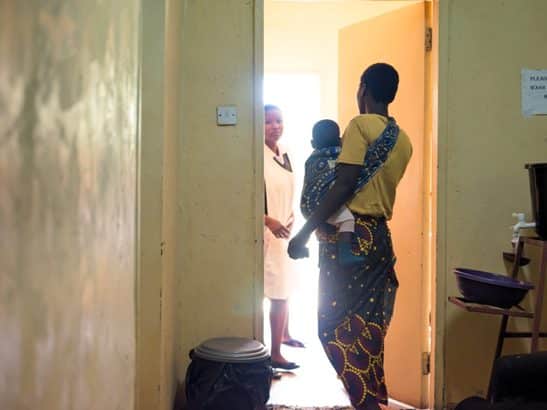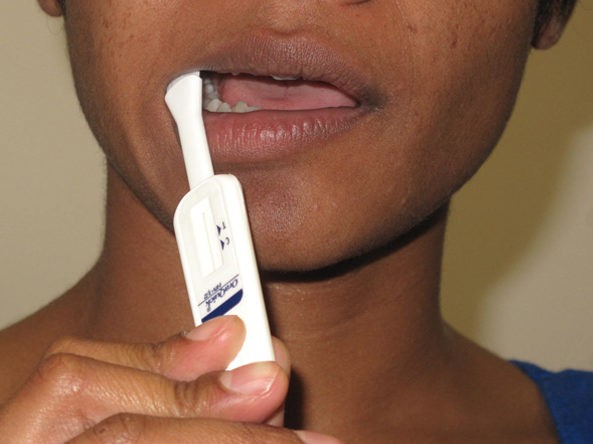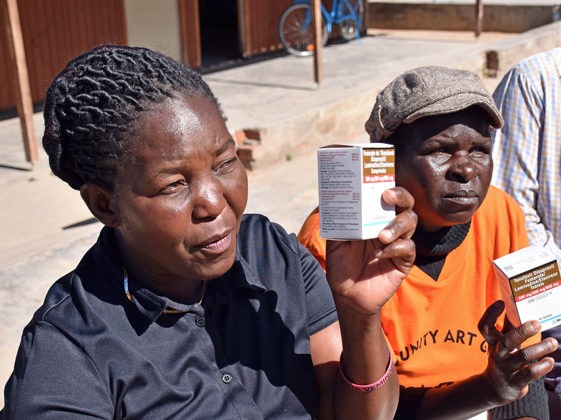Article and Study Summary:
Optimised prevention of postnatal HIV transmission in Zambia and Burkina Faso (PROMISE-EPI): A phase 3, open-label, randomised controlled trial.
Published in:
The Lancet. 2024; 403(10434):1362-71.
https://doi.org/10.1016/S0140-6736(23)02464-9
Authors:
Chipepo Kankasa MD, Anaïs Mennecier PharmD, Beninwendé L D Sakana MD, Jean-Pierre Molès PhD, Mwiya Mwiya MD, Catherine Chunda-Liyoka MD, et al.
Summary
The PROMISE-EPI study was a phase 3, open-label, randomized, controlled trial that evaluated the efficacy of extended infant postnatal prophylaxis guided by point-of care (POC) maternal viral load (VL) testing at the second Expanded Programme on Immunization (EPI-2) visit and at six months, on the rate of postnatal mother-to-child HIV transmission in Zambia and Burkina Faso.
Mothers with HIV and their breastfed infants without HIV attending the EPI-2 visit (infant age 6–8 weeks) were randomly assigned (1:1) to intervention or control groups. In the intervention group, POC maternal VL was measured at EPI-2 and at 6 months. Infants whose mothers had a VL ≥1000 copies/mL were started on lamivudine until the 12-month visit or 1 month after breastfeeding discontinuation, whichever came first. The control group followed national guidelines for prevention of postnatal transmission of HIV. The primary outcome was infant HIV infection at age 12 months, assessed through HIV DNA POC testing at 6 and 12 months. During follow-up, one HIV transmission occurred in the intervention group and six occurred in the control group (p=0.066). While this did not meet the threshold for statistical significance, it should be noted the study was underpowered due to COVID-19 pandemic disruptions affecting enrollment. A post-hoc explanatory analysis found a large and significant reduction in the high-risk period for infants (defined as a maternal VL ≥1000 copies/mL and no postnatal prophylaxis) in the intervention group. The intervention is therefore a promising approach for reducing postnatal HIV transmission, which remains a challenge in several settings.
Please share your thoughts and experiences with us in the comments section below.
Discussion Questions:
1) How could the findings in this study impact policy where you work?
2) What would it take to implement the study intervention in the programs you work with? Do you have any experiences to share?
Full Synopsis:
PDF version available in English, Spanish, Portuguese, French
Study Summary
The PROMISE-EPI study was a phase 3, open-label, randomized, controlled trial that evaluated the efficacy of extended infant postnatal prophylaxis (PNP) guided by point-of care (POC) maternal viral load (VL) testing at the second Expanded Programme on Immunization (EPI-2) visit and at six months, on the rate of postnatal mother-to-child HIV transmission at 12 months.
Study Setting
- In Burkina Faso, mothers attending 32 urban Health and Social Promotion Centers were screened for eligibility and referred to four health care facilities for study procedures.
- In Zambia, screening and study procedures were done at four maternal and child health facilities in Lusaka.
Methods
- All mothers attending EPI-2 with their infants were tested for HIV using a rapid test if no prior test result was documented in the previous three months in Burkina Faso and in the previous one month in Zambia.
- All singleton infants born between 5 and 16 weeks at the time of EPI-2 were eligible to participate in the study if they were accompanied by mothers who were living with HIV, aged ≥15 years, breastfeeding, and intended to continue breastfeeding for at least four months.
- Exclusion criteria included children with HIV infection, children already taking emtricitabine, mothers living outside the study area or intending to move from the area within the next 12 weeks; mothers participating in another clinical trial; and infants with severe congenital malformations, grade 3 or 4 clinical symptoms on the National Institutes of Health Division of AIDS pediatric scale, or a known allergy to the study drug.
- POC early infant diagnosis (EID) was used to identify infants with HIV who were immediately initiated on antiretroviral therapy (ART).
- All infants who were HIV exposed, but uninfected, and their mothers were enrolled and randomly assigned (1:1) to the intervention group or the control group, stratified by site.
- The intervention consisted of:
- The use of a POC platform at EPI-2 and 6-month visits for assessment of maternal VL, with immediate initiation of lamivudine PNP in infants whose mothers had a VL ≥1000 copies/mL, and continuation until the final visit at 12 months or at least one month after breastfeeding cessation, whichever came first.
- VL results were given to the mothers on the same day and those with VL ≥1000 copies/mL were advised to consult their HIV provider to optimize ART.
- Monthly visits for infant lamivudine refills and adherence assessments using a questionnaire. Lamivudine oral solution was delivered according to weight ranges (7.5 mg twice per day if the infant weighed 2–4 kg, 25 mg twice per day if they weighed 4–8 kg, and 50 mg twice per day if they weighed >8 kg).
- In the control group, infants received the standard of care of their country:
- In Burkina Faso, monitoring of maternal VL was done every six months, and infants received nevirapine for six weeks from birth, but none after enrollment.
- In Zambia, national triple-drug PNP (zidovudine, lamivudine, and nevirapine) was extended to 12 weeks for infants at high risk until the end of 2019, with new guidelines in early 2020 recommending continuation of triple-drug PNP until a maternal VL <1000 copies/mL is achieved, with quarterly monitoring.
- In the control group, maternal blood samples were collected at EPI-2, month 6, and month 12 and stored for VL measurement after the trial.
- In both groups, participants received routine counselling for infant feeding and maternal HIV care. The study nurses or community health workers recalled participants for missed visits and visited mothers at home when necessary.
- The primary outcome was postnatal HIV transmission between EPI-2 and 12 months of age, assessed using GeneXpert at month 6 and month 12.
- Secondary outcomes included serious adverse event (SAE) rates (grades 3 and 4) and maternal VL at 12 months.
- An explanatory outcome of ‘time at high risk of HIV transmission’ was added post hoc, defined as the time during which breastfed infants were not protected by PNP and maternal VL was ≥1000 copies/mL.
- Adherence to infant PNP was calculated as the ratio of actual time on lamivudine (based on monthly refills and interviews of mothers) to the expected PNP time.
Study Population and Follow-up
- Between December 2019 and July 2021 in Zambia, and between December 2020 and September 2021 in Burkina Faso, 34,054 mothers attended an EPI-2 visit with their infant (25,093 in Burkina Faso and 8,961 in Zambia) and were screened for HIV.
- Among the 1,692 mothers with HIV (201 in Burkina Faso and 1,491 in Zambia), 1,526 met the eligibility criteria (169 in Burkina Faso and 1,357 in Zambia). The main reasons for non-eligibility included absence of breastfeeding (n=84) and refusal to participate (n=24).
- All enrolled infants were randomly assigned (763 in each group) and 10 infants in each group were then excluded because their POC EID test was positive.
- Overall, of the 1,506 mothers included in the analysis, 1,063 knew their HIV status before the last pregnancy, and all but five were on ART before this pregnancy. Among the remaining 439 mothers with HIV diagnosed during or after this last pregnancy, 18 reported being unaware of their HIV-positive status at the EPI-2 visit.
- Overall, baseline characteristics of mothers and infants were similar between groups. The median age of mothers was 30.6 years (interquartile range [IQR] 26.0–35.0), 98.4% were receiving ART and 11.5% had a VL ≥1000 copies/mL, with a median VL of 20,700 copies/mL (IQR 6,350–83,800).
- Among all enrolled infants, the median age was 6.4 weeks (IQR 6.1–7.1) and 51.4% were boys. PNP was received in the first 6 weeks of life in 91.9% of the infants who were HIV exposed.
- The proportion of mothers lost to follow-up at month 12 was similar between the two groups (17.4% in the intervention group versus 19.9% in the control group, p=0.155). However, the proportion of mothers with a VL ≥1000 copies/mL at EPI-2 who were subsequently lost to follow-up was significantly higher in the control group than in the intervention group (p=0.0085).
- With both groups combined, mothers lost to follow-up were more likely to be younger, Zambian, diagnosed with HIV during the last pregnancy, not taking ART at EPI-2, and to have a VL ≥1000 copies/mL at EPI-2.
- Among the 1,212 infants who attended the month 12 visit, 75.9% were still breastfed, with no significant difference between groups.
- Among the 104 infants in the intervention group who were eligible for extended PNP at EPI-2 (n=87) or month 6 (n=17), all but two initiated lamivudine PNP, with a median time of 0 days (IQR 0–1).
- Median adherence to lamivudine PNP was 86.1% and was higher in Zambia (89.0%) than in Burkina Faso (71.9%). Apart from those lost to follow-up, no participant discontinued lamivudine before the due date.
- The country-specific transmission incidence was 0 per 100 person-years (95% CI 0–0.78) in the intervention group and 1.10 per 100 person-years (95% CI 0.36–2.56) in the control group in Zambia (p=0.029), and 1.59 per 100 person-years (95% CI 0.04–8.86) in the intervention group and 1.66 per 100 person-years (95% CI 0.04–9.24) in the control group in Burkina Faso (p=0.97).
Primary Outcome
- During follow-up, one HIV transmission occurred in the intervention group and six occurred in the control group.
- The corresponding transmission incidence rates were 0.19 per 100 person-years (95% confidence interval [CI] 0.005–1.04) in the intervention group and 1.16 per 100 person-years (95% CI 0.43–2.53) in the control group (p=0.066).
- The only transmission event in the intervention group was a Burkinabe infant whose mother had a VL of 6,350 copies/mL at EPI-2. The infant had been off lamivudine for 5 months before being diagnosed with HIV infection at his final visit.
- Transmissions in the control group occurred between EPI-2 and month 6 (n=2) and between month 6 and month 12 (n=4).
- All mothers of these six infants, who were tested retrospectively, had a VL ≥1000 copies/mL at the time of or at the visit before infant HIV diagnosis. In addition, these six mothers reported their infants had not received PNP in the four months before their positive HIV test.
Secondary Outcomes and Post-hoc Analysis
- The proportion of mothers with VL ≥1000 copies/mL was similar between groups at both month 6 (8.0% in the intervention group and 7.5% in the control group), and month 12 (7.1% in the intervention group and 7.1% in the control group).
- At EPI-2, mothers with VL ≥1000 copies/mL were 12.3 times more likely (95% CI 9.2–16.5) to have another VL ≥1000 copies/mL at month 6 or month 12 than those with VL <1000 copies/mL, and this result was not different between groups or countries.
- A total of 119 SAEs were reported: 65 (54.6%) events in 62 (8.2%) infants in the intervention group and 54 (45.4%) events in 53 (7.0%) infants in the control group (p=0.44).
- The most reported SAEs were grade 3 and 4 anemia and neutropenia, and four SAEs occurred while the infant was taking lamivudine, including one that was considered possibly related to the study drug (anemia).
- In the explanatory post-hoc analysis, the cumulative time at high risk for all infants, when standardized to 100 person-years of follow-up, was 0.56 years (95% CI 0.52–0.59) in the intervention group and 6.38 years (95% CI 6.26–6.49) in the control group.
- Overall, among infants with at least one follow-up visit, 3.5% of infants in the intervention group were at high risk at any time during follow-up compared with 10.5% in the control group (p<0.001).
- Among infants at high risk, mean duration of the high-risk period was 1.5 months (standard deviation [SD] 1.8) in the intervention group versus 6.3 months (SD 3.5) in the control group.
Critical Analysis
The phase 3, open-label, randomized, controlled PROMISE-EPI study found an intervention using POC maternal VL at EPI-2 and at 6 months to extend or initiate infant PNP using twice daily oral lamivudine, resulted in lower postnatal HIV transmission than national standard of care. While the primary outcome did not reach statistical significance, the effect of this intervention was supported by the post-hoc explanatory analysis, which showed a significant reduction in the high-risk period for infants in the intervention group.
The following points should be considered when interpreting the study findings:
- Enrollment was stopped before the target sample size was reached because of disruptions during the COVID-19 pandemic, therefore the study was underpowered to detect a statistically significant difference in the primary outcome.
- There was no difference in maternal VL suppression between the groups, which suggests the intervention effect was driven by extended infant PNP. This also demonstrates the added value of PNP for prevention of vertical transmission during breastfeeding when mothers are on ART and not virally suppressed.
- Mothers in the intervention group with elevated POC VL results were advised to consult their ART provider; however, this intervention did not affect maternal VL suppression rates, which suggests more than passive referral was required for these mothers. Stronger measures to address and support ART adherence in mothers with viremia are essential and could further reduce the risk of postnatal transmission.
- More mothers in the control group with unsuppressed VL were lost to follow-up, and therefore the 12-month outcome of their infant was not documented, which may have contributed to an under-estimation of the intervention effect. This also suggests that POC VL, combined with monthly visits for their child on PNP, is a potential strategy to improve maternal-infant retention and that suboptimal maternal adherence to ART did not adversely impact infant PNP adherence.
- The study was implemented in two countries with different health systems and HIV epidemiology, but predominately in urban settings. It is unknown whether the intervention effect can be generalized to more rural settings.
- Integration of the intervention within routine EPI-2 activities was shown to be feasible, and was facilitated by the fact that antenatal care, EPI, and healthy baby clinic activities often take place within a maternal and child health building, and with shared health care workers.
- In addition to the prevention benefits, providing an intervention during the well-attended EPI-2 visits enabled the identification and linkage of 20 children with HIV who were undiagnosed, as well as 18 mothers with HIV who may have been missed during antenatal care or who were recently infected. However, over 34,000 women were screened to achieve this and the cost-effectiveness of such an approach remains unclear.
- In total, more infants were diagnosed with HIV at EPI-2 (n=20) than over the next 10-11 months (n=7), which suggests that in this setting most infections occurred during pregnancy, delivery or early in the postnatal period.
- Three in four women were still breastfeeding when the intervention ended at 12 months, suggesting extension of the intervention could be of further benefit.
Implications
The phase 3, open-label, randomized, controlled PROMISE-EPI study demonstrated that an intervention employing extended infant PNP guided by POC maternal VL at the EPI-2 visit and 6 months, could reduce postnatal vertical transmission. While the strategy utilizes existing tools, it relies on programs’ ability to dedicate resources to scale up POC technologies for EID and maternal VL testing, which has major cost and implementation implications. Nevertheless, the effect of the intervention suggests this is a promising approach for reducing postnatal HIV transmission, which remains a challenge in several settings.
This article synopsis was written by Dr. Cassia Wells. Share your thoughts on this article or suggest an article for Journal Club by emailing her at caw2208@columbia.edu.
Articles of Note:









